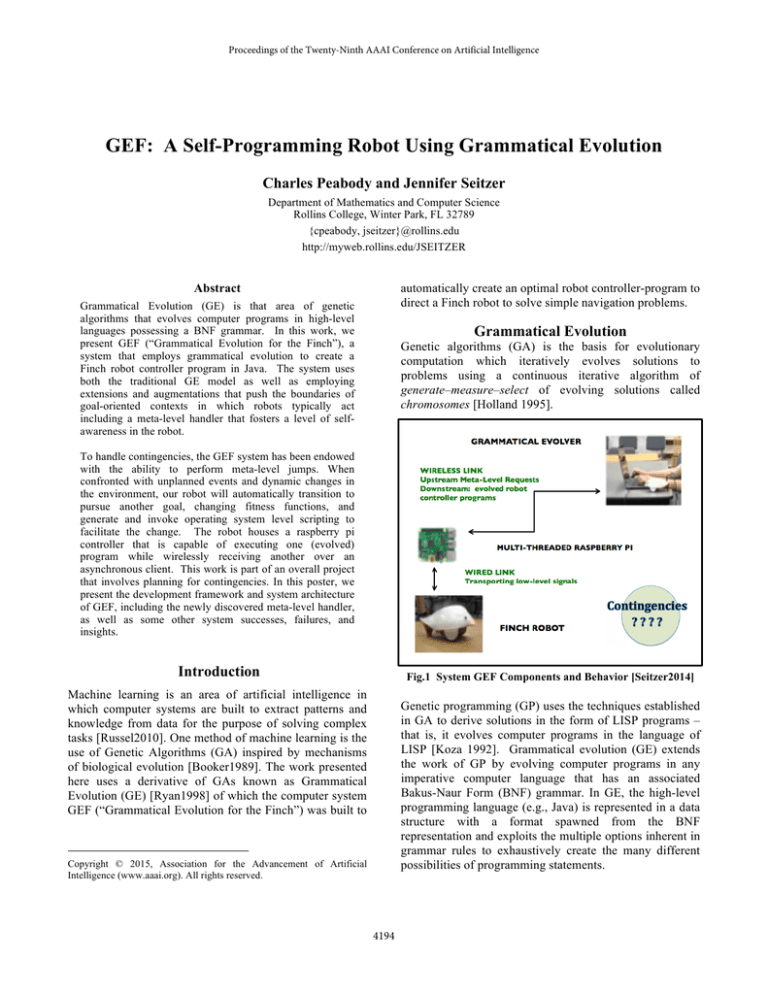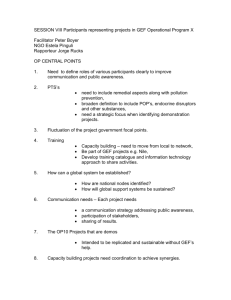
Proceedings of the Twenty-Ninth AAAI Conference on Artificial Intelligence
GEF: A Self-Programming Robot Using Grammatical Evolution
Charles Peabody and Jennifer Seitzer
Department of Mathematics and Computer Science
Rollins College, Winter Park, FL 32789
{cpeabody, jseitzer}@rollins.edu
http://myweb.rollins.edu/JSEITZER
automatically create an optimal robot controller-program to
direct a Finch robot to solve simple navigation problems.
Abstract
Grammatical Evolution (GE) is that area of genetic
algorithms that evolves computer programs in high-level
languages possessing a BNF grammar. In this work, we
present GEF (“Grammatical Evolution for the Finch”), a
system that employs grammatical evolution to create a
Finch robot controller program in Java. The system uses
both the traditional GE model as well as employing
extensions and augmentations that push the boundaries of
goal-oriented contexts in which robots typically act
including a meta-level handler that fosters a level of selfawareness in the robot.
Grammatical Evolution
Genetic algorithms (GA) is the basis for evolutionary
computation which iteratively evolves solutions to
problems using a continuous iterative algorithm of
generate–measure–select of evolving solutions called
chromosomes [Holland 1995].
To handle contingencies, the GEF system has been endowed
with the ability to perform meta-level jumps. When
confronted with unplanned events and dynamic changes in
the environment, our robot will automatically transition to
pursue another goal, changing fitness functions, and
generate and invoke operating system level scripting to
facilitate the change. The robot houses a raspberry pi
controller that is capable of executing one (evolved)
program while wirelessly receiving another over an
asynchronous client. This work is part of an overall project
that involves planning for contingencies. In this poster, we
present the development framework and system architecture
of GEF, including the newly discovered meta-level handler,
as well as some other system successes, failures, and
insights.
Introduction
Fig.1 System GEF Components and Behavior [Seitzer2014]
Machine learning is an area of artificial intelligence in
which computer systems are built to extract patterns and
knowledge from data for the purpose of solving complex
tasks [Russel2010]. One method of machine learning is the
use of Genetic Algorithms (GA) inspired by mechanisms
of biological evolution [Booker1989]. The work presented
here uses a derivative of GAs known as Grammatical
Evolution (GE) [Ryan1998] of which the computer system
GEF (“Grammatical Evolution for the Finch”) was built to
Genetic programming (GP) uses the techniques established
in GA to derive solutions in the form of LISP programs –
that is, it evolves computer programs in the language of
LISP [Koza 1992]. Grammatical evolution (GE) extends
the work of GP by evolving computer programs in any
imperative computer language that has an associated
Bakus-Naur Form (BNF) grammar. In GE, the high-level
programming language (e.g., Java) is represented in a data
structure with a format spawned from the BNF
representation and exploits the multiple options inherent in
grammar rules to exhaustively create the many different
possibilities of programming statements.
Copyright © 2015, Association for the Advancement of Artificial
Intelligence (www.aaai.org). All rights reserved.
4194
involving the transfer of meta-programs (i.e., scripts) as
well as object-level programs (i.e., Finch controllers).
As implied in Figure 1, GEF is continually transferring,
decoding, and responding to messages (in the form of
Finch controller programs). Additionally, each evolved
program, itself, is intentionally endowed with meta-level
scaffolding including a software-level program counter that
enables the Finch to create an alert message such as:
“Alert: send new program; completed instruction 8.” The
‘alert’ messages are directly mapped to a vocabulary of
contingencies among some of which include unavoidable
obstacle (e.g., a wall), or internal meta event (e.g., right
wheel broke off or battery low).
Incremental Testing and Future Plans
Our first meta-level jumping experiment evolved a
program that enabled the Finch to successfully navigate the
proper exit of a room through a specified door. We then
intentionally closed that door at which point the robot had
to (a) realize there was a problem, (b) alert the meta-script
with the current instruction number, and (c) wait for
another program to be wirelessly downloaded. Among
other meta-triggering events, we elaborated the system to
handle internal-meta-problems (i.e., self awareness of
blocked right-wheel / left-wheel). The next of our future
plans is to “bank” effective (previously evolved) programs
as well as engage a real-time evolver to handle a broader
repertoire of contingencies including environmental and
architectural anomalies some of which include holes in the
floor and faulty sensors.
Figure 2: GEF System Architecture and Algorithm
An autonomous robot uses on-board controllers to
perceive, decide, and act on their environment [Russell
2010]. There is a growing demand for autonomous robots
to act intelligently in dynamic environments. In this work,
we are applying grammatical evolution to create optimal
robot-controlling programs to be executed by the robot
controller of the Finch robot.
Novel Aspects of System GEF
The long-term goal of this research is to produce real-time
evolution of an optimal robot controller program. By realtime, we mean evolution of new versions of a controller
program during execution of a former version. To date, we
have been successful in partially achieving this goal by
integrating into system GEF a meta-level handler (as
shown above in the top module of Figure 2). At any given
point, the robot is executing the most recent, most
appropriate, controlling program that had been evolved
using the traditional framework embodied in the other four
modules of Figure 2: genome generator, phenome
generator, fitness function, and selector [Ryan1998].
References
Booker, L. B., Goldberg, D. E., and Holland, J. H. 1989.
Classifier systems and genetic algorithms. Artificial Intelligence
40(1/3), 235-282.
Holland, J. H.,1995. Hidden Order: How Adaptation Builds
Complexity. Reading, Mass.:Addison-Wesley.
Koza, J. R.,1992. Genetic Programming: On the Programming of
Computers by Means of Natural Selection. Cambridge, Mass.:
MIT Press.
O'Neill M., Ryan C. Under the Hood of Grammatical
Evolution. In Banzhaf, W., Daida, J., Eiben, A. E., Garzon, M.
H., Honavar, V., Jakiela, M., & Smith, R. E. (eds.). GECCO-99:
Proceedings of the Genetic and Evolutionary Computation
Conference, July 13-17, 1999, Orlando, Florida USA. San
Francisco, CA: Morgan Kaufmann.
Russell, S., Norvig, P., and Davis, E. 2010. Intelligent Agents
Artificial Intelligence: A Modern Approach 3rd Edition. Upper
Saddle River, NJ:Pearson-Prentice Hall.
Ryan C., Collins J.J., O'Neill M. 1998. Grammatical Evolution:
Evolving Programs for an Arbitrary Language. Proceedings of
the First European Workshop on Genetic Programming. London,
United Kingdom: Lecture Notes in Computer Science 1391.
As shown in Figure 1, GEF has three loci of computation:
(1) the laptop housing the grammatical evolution engine
and a server to push evolved programs, (2) the raspberry PI
housing the scripts to receive “alert messages” from the
Finch as well as processes executing the current controller
program and serving in the role as a client to the programtransporter on the laptop, and (3) the Finch robot, itself,
following the commands mandated in the current controller
program. All three of these entities possess their own
operating systems with corresponding socket call APIs and
scripting languages that enable client-server interactions
4195





